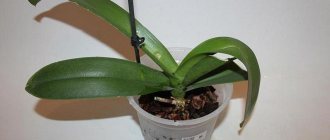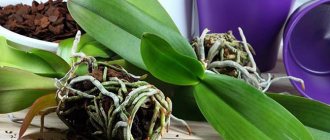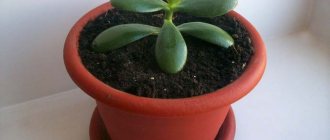Do you have an orchid growing, but you don’t know how to replant it at home? Read the article, it contains a lot of useful tips and instructions.
The orchid, just like the rose, can be called the queen of flowers. Graceful flowers, decorative leaves, intertwining roots and stems create a plant of incredible beauty. But this flower, like all the others, needs good care, an important component of which is replanting. It needs to be done correctly and on time - the further development of the plant and the abundance of flowering, as well as the duration of the adaptation process, depend on this.
Read another article on our website that tells how to propagate an orchid at home with children, cuttings, roots, and seeds. All methods are described in detail.
This article describes the timing, as well as the rules for transplanting a home orchid. You will learn how to replant a flower after the store and why to do it at all. Read on.
Why replant an orchid when grown at home: is it replanted at all, is it possible?
Orchid transplantation at home
Various circumstances may arise under which a transplant is performed. Why replant an orchid when growing it at home? Is it possible to replant at all? Yes, this can and should be done. Here are the circumstances under which flower breeding experts advise doing this:
- Replanting is required once every 3-4 years after purchasing or replanting the plant.
- If it is noticed that the roots have begun to appear from the pot, i.e. it has become too small for the plant.
- If the orchid is very sick, all its leaves begin to turn yellow.
- Unsightly appearance and condition of the substrate in which the flower grows. Mold or severe dryness of the upper fragments has appeared on the surface, which indicates a loss of the filler’s ability to pass water and air.
- The plant does not bloom for several years, and then it needs a good shake-up in the form of a transplant.
- If necessary, divide the orchid.
If these signs are not observed, it is better not to touch the orchid - it does not really like to be disturbed. It is also not recommended to do this during the flowering process; it is better to wait until it is over, unless an urgent transplant is needed.
Varieties and their features
There are many types of this beautiful flower. The flower has an unusual structure, which is quite interesting. It has a special thickening at the end of the stem, in which it stores nutrients; these are called pseudobulbs.
This thickening comes in different forms. Its shape can be cylindrical or egg-shaped. Orchid flowers, despite the number of varieties, have the same structure. Although there are about three thousand varieties.
Timing: when can an orchid be replanted?
Replanting an orchid at home
This operation should be carried out when the dormant period of the inflorescences and the entire plant has ended. But there are types of orchids in which the dormant period is weakly expressed, for example, phalaenopsis, which blooms almost all year round with short breaks. Therefore, if new shoots of a plant do not develop in the absence of signs of disease, it means that it is entering a dormant period. This is the best time to replant. This time usually occurs in the spring - late February and March. This is the best time to replant an orchid.
Opaque pots
Is it possible to plant an orchid in an opaque pot? The transparency of the container in which the flower is grown is not such a mandatory factor; it can also be grown in an opaque container. There is one big but... you need to be able to organize proper watering and not doubt it, since it will be possible to check the condition of the root system only when replanting the plant .
An orchid can be planted in an opaque pot, but it requires close care.
We can safely say that an opaque pot can be the culprit for the fact that the gardener misses the beginning of the death of the root system and learns about this trouble at the moment when a bush without roots falls out of the opaque pot.
Experienced orchid lover:
- Knows the correct composition of the soil, which will not cause waterlogging;
- Will use the right water when watering;
- Will be able to arrange watering with the correct frequency at a certain period of the year.
IMPORTANT! You need to be able to regulate watering.
Frequency of orchid transplantation at home: how often?
Replanting an orchid at home
Many novice flower lovers ask the question: “How often to replant an orchid?” . What determines the frequency of transplanting inflorescences at home?
- The answer to this question depends on what composition of the substrate is in the container.
- It may consist of moss, and then it needs to be replanted more often - once every two years .
- If the main part of the substrate is bark, which decomposes more slowly, then you can replant it once every three years.
Of course, these dates are indicated for planned replantings, when the inflorescence looks completely healthy and has no signs of damage by insects.
How does choosing the right container affect the plant?
If we talk about the size of the orchid pot, then it is very important to choose the right size.
In a large container, the soil will dry out unevenly , which will lead to rotting of the roots, and in a container that is too small, the orchid may simply turn over, since it will not have proper support.
The color of the pot should also be taken into account. After all, it affects the heat capacity. A dark color promotes rapid heating and slow heat transfer, while a light color does the opposite. Also, soil in dark pots dries quickly, which is not convenient during hot periods.
Substrate for orchid transplantation at home: what is it made of?
Substrate for transplanting orchids at home
To transplant orchids at home, you need to choose a high-quality substrate. The health and further flowering process of the plant largely depends on this. What is it made of? You can buy a specialized one at retail outlets, but it comes in two types:
- For epiphytic (i.e. with aerial roots). It's called Phalaenopsis Mixture.
- For terrestrials - “Mixture for Cymbidium”.
The first mixture is used for flowers growing on trees with long aerial roots. Therefore, the substrate for them must be breathable, because the roots of these flowers take part in photosynthesis and they do not need soil, only moisture, to grow. The composition of such mixtures usually includes:
- Pine bark
- Ground fern root
- Activated carbon
- Cut cork
- Sphagnum in small quantities
The second type of mixture is denser, because it is intended for orchids living on the ground. It contains more of these ingredients:
- Sphagnum moss
- Lowland peat
- Leaf ground
- Coal
Sometimes various synthetic materials, such as perlite or foam, are used as a substrate. You can also use:
- Expanded clay
- Shell rock
- Pumice
The substrate can be made at home. Pine bark is used for this:
- First disinfect it - hold it over steam for half an hour or boil it in water.
- After this, dry and boil again. This treatment kills all pathogenic organisms.
- Place to dry again and then cut into pieces up to 2 cm .
To the bark prepared in this way, add dry and finely chopped sphagnum moss and just a little peat coal. You can now fill the pots with this mixture.
Children's transplantation
When can you transplant an orchid into a separate container, separating it from an adult specimen? At some stage, mature plants will develop suckers and need to be replanted. This should be done when the baby has a 5 cm root.
When separating, the shoot must be cut off along with part of the peduncle, and the cut site on the child and adult should be treated with an antiseptic. Then dry the plant in the open air for half an hour. You need to take a small container - 7-10 cm in diameter. You can use a regular disposable cup, having previously cut slits and holes in it. Next, replant the shoot according to the same scheme, but use a substrate with a finer fraction (up to 10 mm) and be sure to take a little soil mixture from the mother pot.
And if all stages of transplantation were carried out correctly, then exotic pets will delight you with wonderful flowers for a long time.
Which pot is best to replant a home orchid?
It is better to replant the orchid in a transparent pot.
Most orchids have large roots that like to entwine the pot from the inside and even look out. Therefore, when choosing a new container for a flower, you need to focus primarily on the size of the root system. But, given that the base of the flower will grow further, you need to add a few centimeters to the diameter. Which pot is best to replant a home orchid?
Worth knowing: For a large orchid with intensive growth, you can buy a pot, as they say, “for growth,” so as not to replant it often.
Orchid lovers most often grow their “beauties” in plastic transparent pots or containers. What are the advantages of such containers? Here is the answer:
- The roots are clearly visible and you can constantly monitor their condition. With normal soil moisture, the roots are usually green, but as the substrate dries, they gradually turn gray, which indicates the need for watering.
- In plastic containers, unlike clay ones, the roots do not grow to the walls of the container and therefore are not injured during replanting.
Although clay containers have their advantages:
- In them, the base-root does not overheat, which is very important for orchids.
- Do not overwater the plant because the moisture will last longer.
- In addition, a clay pot is much heavier than a plastic one and therefore will not tip over. Orchids are planted in such pots, some of the roots of which completely dry out and die during the dormant period.
Be sure to make drainage holes in the containers. This will provide the roots with faster drying and ventilation, which will protect them from rotting. Flower lovers with no experience often overwater the plant for fear of drying it out. Drainage holes will help in this case too.
Worth knowing: Plastic containers have one drawback - they have a rather simple, not very sophisticated appearance, compared to the flower itself. To correct this shortcoming, you can buy a beautiful flowerpot that will completely hide the plastic.
There is another way out - you can put a plastic pot in a low glass vase. The space between the walls of the vase and the pot is filled with some kind of jewelry or tinsel, balls or floral fillers. This needs to be done carefully so that the multi-colored filler does not distract from the beauty of the orchid flowers.
Remember: Do not buy large containers for orchids. In small ones - up to 15 cm in diameter, it feels much better and blooms longer.
Which container to choose?
A properly selected pot is of great importance for the proper development of the orchid root system . Let's consider which containers are most suitable for this flower.
- A good pot for an orchid should provide drainage of excess moisture, access of air to the roots, and the ability to safely remove the flower if necessary. As a result, one of the main conditions is the mandatory presence of a hole for drainage. It would be good if there were similar holes on the bottom and on the walls. If the purchased container does not have drainage holes, they can be easily made with a hot nail or knitting needle.
- When choosing the “right” pot, one should not forget that the root system of many orchid varieties is involved in the process of photosynthesis, so the best option is for the container to be transparent. Today, specialized stores have a fairly wide range of pots of this type, made of plastic. This material allows you to monitor the development of the root system, the condition of the substrate, the outflow of moisture, and maintain the optimal temperature regime, which is so necessary for the flower.
- Lovers of everything environmentally friendly tend to choose clay pots when choosing: the material is natural, no toxic substances are used in production, clay absorbs moisture well and allows air to pass through. But there are a number of nuances here. Clay is a porous material, and orchid roots often simply grow to the walls of the container. This makes it difficult to transplant the plant, as there is a risk of injury. Clay containers are still more relevant for experienced gardeners, but beginners should get their hands on growing orchids in plastic pots.
- The orchid container must be stable to prevent the pot from tipping over. A decorative flowerpot can provide stability, but you need to remember how to replant correctly: the distance between the walls of the pot and the flowerpot should be at least 1 - 2 cm.
Important : When choosing the volume of a pot, one must take into account the main principle: the height of the container should be equal to its diameter.
We recommend watching a video about choosing the right pot for replanting an orchid:
Read more about how to choose a pot and soil here.
How to transplant children, one child, a shoot of a home orchid: step-by-step instructions
Replanting a baby home orchid
An orchid growing in normal, ideal conditions can produce young shoots, or babies. This is a great opportunity to propagate the plant. What should be done? How to transplant children, one child, a shoot of a home orchid? Here are the instructions step by step:
- The baby should have fairly long roots - more than 5 cm and 3-4 leaves - these are the most suitable parameters for transplantation.
- Children usually appear on the stem or near the root collar. Using a sharp knife, you need to cut off part of the stem with the baby, stepping back to the sides at a distance of about 1 cm . Sprinkle the cut area with coal.
- Prepare a small glass in advance, preferably a plastic one, and add a small layer of drainage.
- Place the baby in a glass and carefully cover it with substrate. for the first 3-4 days .
- Place the glass with the baby in a place where the air humidity is high. You can simply spray the surface of the window sill where the glass is located more often. Try not to get it on the leaves.
The baby will grow in such a container for about a year, after which it can be transplanted into a larger container. An orchid grown from a child will bloom in three years .
Further proper care of the phalaenopsis orchid plant after transplantation, growing conditions
After replanting, you need to provide proper and timely further care for the orchid. Here are the conditions for growing a phalaenopsis orchid plant:
Proper care of an orchid is to shade the window so that the sun does not burn the leaves of the flower.
- As mentioned above, immediately after the transplantation is made, the container is placed on a sunny windowsill for a week, but shaded from direct sunlight. Otherwise, if this is not done, the orchid leaves will lose their decorative appearance, wrinkle and become wilted.
You can water the flower after transplanting only after a couple of weeks.
- water the plant after replanting only after 2 weeks . The fact is that orchid roots are susceptible to various fungal diseases. Therefore, the root system needs to be slightly dried to avoid this. Find out how to properly water an orchid here .
Spraying the plant so as not to dry it out
- But, in order not to dry out the plant, spray the leaves, or, even better, wipe them with a wet sponge. In this case, under no circumstances should water get into the depths of the rosette of leaves. This can lead to their rotting.
Orchid grows at optimal temperature
- It is important to maintain optimal temperature. The orchid does not like heat, it needs a temperature no higher than +21-22°C , but it should not fall below 18°C . Otherwise, the inflorescences get stressed, which is very undesirable for these sissies.
Feed the orchid
- A blooming orchid needs feeding. Use only mineral mixtures. Organic ones are not suitable for feeding flowers, since they can introduce diseases into the soil.
Excessive nitrogen nutrition can cause leaf growth to the detriment of flowering. Nowadays you can find special fertilizer compounds for orchids in stores. In any case, it will be good to use an all-purpose fertilizer for flowering plants. They must be diluted strictly according to the instructions so as not to harm the flower. They need to be added along with water for irrigation.
Methods and technology
There are several methods for replanting an orchid. Replanting orchids is not that easy.
Transfer to another container
The most popular method is transplanting into another container. How to transplant an orchid into another pot? An entire technology has been developed for this purpose, which we will get acquainted with below.
Landing on the wick
Wick landing is also a commonly used method. A wick is stretched at the bottom of the pot, through which water rises, supplying the roots and bark with moisture. There are wick pots available commercially, but you can make them at home.
Double pot
Planting in a double pot is called a semi-closed system: the inner pot has drainage holes, but the outer pot does not. With this system of growing flowers, it is better to make the drainage layer from expanded clay. Expanded clay is a moisture-absorbing and breathable component, which is the best drainage for this flower crop.
In expanded clay
Sometimes the phalaenopsis orchid is grown only in expanded clay, replacing the bark with it. In this case, the expanded clay must be washed so many times until the water becomes clear.
Growing in water without soil
Another method of growing this crop is in water without soil. Flowers that grow in a transparent glass vase look great. You can also use other transparent containers, for example, plastic flowerpots with a very convenient bottom on which to place the plant.
Transplanting an orchid onto a bark block
You can transplant the orchid onto a bark block. How to transplant an orchid at home onto a large piece of bark?
If you plan to plant an orchid in this way, it is better to place it in a greenhouse, where the humidity is higher than in an apartment.
Breeding rules on the block:
- Find a large piece of pine bark or a thick, strong grape vine.
- Scald the bark with boiling water to remove harmful larvae and microorganisms.
- Place moss on the block, then tie the orchid, covering the roots with moss. When humidity is low, spray them regularly with water.
Lighting should be 10 hours a day. Maintain the daytime temperature at 20-25 degrees, and at night - 16-20 degrees.
Planting in moss
Another method for growing mini orchids. They are planted in moss.
Closed orchid planting system
Flower growers have mastered another method of planting orchids - in a closed system. In a closed system there are no drainage holes, so oxygen reaches the roots only from above. Expanded clay is placed at the bottom of the container, then bark with pieces of coal to reduce rotting of the roots.
Boiling drainage
Drainage, in the form of pebbles, expanded clay, must be boiled for 10-15 minutes to destroy all pests. Then dry.
If there is no flowering after transplantation: what to do?
Lack of flowering after transplantation
After transplantation, the orchid should increase its green mass and bloom after a certain time. This usually happens after 3-4 months . But what if the inflorescences do not appear for much longer? What to do if there is no flowering after transplantation? This problem can occur for several reasons:
- The plant is overfed with nitrogen fertilizers , active leaf growth is observed, they become larger than they should be during normal development. In this case, feeding should be stopped for a month.
- The transplant was not carried out in a timely manner . For example, if for some reason an orchid was transplanted at the time when it bloomed last year, then it most likely will not bloom this year. The plant will direct all its energy to restoring its root system, and not to flowering.
- Perhaps you made mistakes during transplantation . If the plant is not firmly fixed in the substrate, then when you move the pot, it begins to dangle in it, and the roots and stems will receive microtrauma. The plant does not have the opportunity to direct its energy to flowering, experiencing constant stress.
- Insufficient lighting and low humidity . You need to move the pot to a lighter windowsill and spray its surface to increase the humidity of the surrounding air.
Follow these tips, and your flower will soon delight you with its unique blooms. It's worse when the plant begins to wilt. What to do? Read on.
Strengthening the orchid
Unlike many other ornamental plants, the orchid does not have thin root shoots that would quickly develop and fix it in the ground. Therefore, we need to help her in this matter. After all, even movements of a few millimeters will inevitably lead to the orchid stopping growth for a while. This is especially noticeable in cases where the sensitive tips are damaged due to movement.
You can cope with the task in different ways. For example, stores have special fasteners in the form of thin wire. It is fixed on the pot, after which it secures the plant.
You can also stick a long, strong stick (like those that come with rolls and sushi) into the ground (carefully, without damaging the roots) and tie an orchid to it.
Some flower lovers wrap the plant with nylon tights several times, securing them relative to the pot. Yeah, it's not too pretty. But this is a temporary measure - after a few weeks, the tights can be safely removed, since the orchid will already be fixed in the pot.
What to do if your home orchid withers after transplantation?
A home orchid withers after transplantation.
Most likely the plant is sick. If planting rules are violated, when mechanical damage to the roots occurs, the leaves do not receive full nutrition. What to do if your home orchid withers after transplantation? Here are the tips:
If you watered a lot, replant the plant:
- With good watering and stagnation of liquid at the bottom of the container, especially if there is no drainage, the roots may begin to rot.
- Then the wilting will soon be replaced by yellowing of the leaves and the plant may die.
- Here an emergency orchid transplant will be needed to save it.
Control pests:
- Another reason could be a pest attack.
- Spider mites, the worst pests of indoor plants, thrive in dry air.
- It can be difficult to notice them right away - they are very small and the bad effects begin to appear when there are a lot of them.
- Whiteflies and scale insects also harm orchids. Providing optimal air humidity will help to significantly reduce the number of these insects.
Protect from the sun:
- If the orchid is not protected from direct sunlight, its leaves will begin to wilt.
- This indoor flower feels best on windows that face east, where the sun appears only in the morning and for a short time.
Containers must be provided with drainage holes, and they need to be made not only at the very bottom of the container, but also on the sides to ensure good air exchange for the roots.
How to properly water a home orchid flower?
Well-groomed orchid flowers
Watering a home orchid flower is carried out by immersion in water, the temperature of which is not lower than +20°C , so as not to cause stress to the plant. How to do this correctly? Here is the answer:
- To do this, take a cup with warm liquid and place the container with the plant in it for 20 minutes .
- Then take it out and place it on a wire rack to drain off excess water.
- Then place the flower in its usual place.
In winter, the number of waterings should be reduced, but in summer, on the contrary, this should be done more often, at least twice a week. It is necessary to monitor the pseudobulb - if it has lost turgor, then watering is necessary.
Important: It is forbidden to take long breaks between waterings. The orchid is a tropical plant that naturally lives in times of frequent rain and high humidity. Therefore, drought is detrimental to it.
Preparation: materials and tools
Once it has been decided when the orchid can be transplanted, it is worth preparing materials and tools. They should be on hand so that the process goes quickly and without complications. To work you will need:
- pot;
- sharp and clean scissors for cutting roots;
- container with warm and clean water (35 ⁰С);
- alcohol-free antiseptic;
- crushed stone or pebbles as drainage (fraction size 10-20 mm).
The drainage and working tools must be washed in boiling water.
How to replant an orchid flower if the root is rotten: tips
Replanting an orchid flower if the root has rotted
Infrequently, but there are cases when novice gardeners, as a result of improper care, have the roots of an orchid rot. This can happen to all the roots or to a large part of them at once. Is it possible to save the plant then? How to replant an orchid flower if the root is rotten? Here are the tips:
- To revive orchids whose roots have completely died, you need a small window greenhouse.
- In the container where the leaf rosette will be located, you need to pour a small layer of drainage - this can be expanded clay or pebbles.
- Place sphagnum moss on top, which is previously kept over steam and dried.
- Now moisten the substrate and place the leaf rosette in it.
- Transfer to a greenhouse, where a constant temperature should be maintained within +21 - +27°C and high humidity of about 100% . The light should be bright, but diffused - direct sunlight is detrimental to leaves during this period.
After 3-4 weeks of this regime, root rudiments will begin to appear at the base of the leaf rosette and then they will begin to grow. Epin , to the water for irrigation .
If a diseased orchid has several living roots left, or even just one, the chances of saving it increase:
- After trimming the rotten roots, you need to rinse the remaining living roots under warm water and sprinkle the cut areas with charcoal.
- A pre-prepared pot up to 8 cm in diameter is filled with ordinary substrate and a leaf rosette with roots is planted in it.
- Next, the plant is treated as in the first case, placing it in a greenhouse.
If everything went well, new roots will begin to grow in 2-4 weeks .
Is it possible to replant a flowering orchid while it is blooming?
You can replant orchids during flowering, but in the most urgent cases.
There is only one situation in which you can replant a blooming orchid - if it is in danger of dying for any reason and you need to choose one of two:
- The orchid will fade, but then die, having spent its last energy on flowering.
- The peduncle is cut short, but later with good care, the plant is completely restored and after a while it will bloom again.
What to do in the second case? Adviсe:
- Prepare fresh substrate and pot. How to do this has already been said above in the text.
- Cut the flower stalks of the orchid to about 2/3 of the length. By the way, the flowers can be placed in water - they will last for almost a week.
- Carefully remove the plant from the pot and inspect the roots, cutting out any rotten ones.
- If the substrate is in normal condition, i.e. there is no mold or its smell, it is not overdried or, on the contrary, very waterlogged, then in this case you need to try to preserve it as much as possible without shaking off the roots. Otherwise, proceed as with a regular transplant, the procedure of which has already been described.
- Now you need to place the plant in the pot and secure it well there.
All that remains is to put the orchid, transplanted during flowering, into the greenhouse and observe how it will feel further. Do not forget to follow all the rules for caring for this flower, which are no more complicated than the rules for caring for other indoor flowers.
Transplant instructions
Now, after all the preparatory work, when the orchid can be transplanted, it’s worth starting the process. It takes place in several stages.
- Removing from an old container. The difficulty of this stage is that the rhizomes of the tropical beauty are fragile and easy to damage. Therefore, we act like this - we remove the loose upper part of the substrate, and then soak the remaining lump so that the operation is painless. If the roots are tightly adhered to the walls, then you can cut the pot with scissors and soak the lump in warm water.
- Next comes washing the roots. To completely soften the rhizome, keep it in warm water for 30 minutes, then carefully remove the remaining bark. It is not worth tearing off dried pieces, since the integrity of the roots is more important. To consolidate the result, the roots should be rinsed with a watering can.
- The next stage is inspection and pruning of the roots. All rotten and blackened parts must be removed to a healthy place. Spray the cut areas with an antiseptic or dust with coal dust.
- Sometimes the roots grow so much that they prevent the lower leaves from growing normally, and they turn yellow. Such foliage must be removed. Also treat the cut area with an alcohol-free antiseptic or sprinkle with charcoal powder.
- Before placing the plant in the substrate, it must be dried. The best way is in a natural way - that is, in the air, for 5-6 hours. It is allowed to remove excess moisture with a napkin.
- Pour a 3-4 cm layer of drainage into the prepared container. Then place the roots in the pot and add the substrate in small portions. The container must be shaken so as to evenly distribute the mixture and fill all free areas. The growing point of the orchid should remain above the level of the substrate. It is also necessary to add a little substrate from an old pot to the fresh mixture, since it contains microorganisms and fungi that are vital for the orchid’s nutrition.
- After transplantation, the plant needs to be saturated with moisture. To do this, lower the pot into a basin of warm water and leave for 30 minutes. Then the excess liquid must be allowed to drain. Next watering in 10-14 days.











